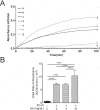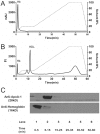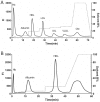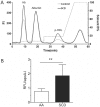Anion exchange HPLC isolation of high-density lipoprotein (HDL) and on-line estimation of proinflammatory HDL
- PMID: 24609013
- PMCID: PMC3946658
- DOI: 10.1371/journal.pone.0091089
Anion exchange HPLC isolation of high-density lipoprotein (HDL) and on-line estimation of proinflammatory HDL
Abstract
Proinflammatory high-density lipoprotein (p-HDL) is a biomarker of cardiovascular disease. Sickle cell disease (SCD) is characterized by chronic states of oxidative stress that many consider to play a role in forming p-HDL. To measure p-HDL, apolipoprotein (apo) B containing lipoproteins are precipitated. Supernatant HDL is incubated with an oxidant/LDL or an oxidant alone and rates of HDL oxidation monitored with dichlorofluorescein (DCFH). Although apoB precipitation is convenient for isolating HDL, the resulting supernatant matrix likely influences HDL oxidation. To determine effects of supernatants on p-HDL measurements we purified HDL from plasma from SCD subjects by anion exchange (AE) chromatography, determined its rate of oxidation relative to supernatant HDL. SCD decreased total cholesterol but not triglycerides or HDL and increased cell-free (cf) hemoglobin (Hb) and xanthine oxidase (XO). HDL isolated by AE-HPLC had lower p-HDL levels than HDL in supernatants after apoB precipitation. XO+xanthine (X) and cf Hb accelerated purified HDL oxidation. Although the plate and AE-HPLC assays both showed p-HDL directly correlated with cf-Hb in SCD plasma, the plate assay yielded p-HDL data that was influenced more by cf-Hb than AE-HPLC generated p-HDL data. The AE-HPLC p-HDL assay reduces the influence of the supernatants and shows that SCD increases p-HDL.
Conflict of interest statement
Figures











Similar articles
-
The Mechanism of Proinflammatory HDL Generation in Sickle Cell Disease Is Linked to Cell-Free Hemoglobin via Haptoglobin.PLoS One. 2016 Oct 7;11(10):e0164264. doi: 10.1371/journal.pone.0164264. eCollection 2016. PLoS One. 2016. PMID: 27716784 Free PMC article.
-
Analyzing of high-density lipoprotein subfractions and low-density lipoprotein subfractions in human serum with anion-exchange chromatography.Atherosclerosis. 2009 Jun;204(2):e52-7. doi: 10.1016/j.atherosclerosis.2008.10.031. Epub 2008 Nov 8. Atherosclerosis. 2009. PMID: 19091316
-
Lipoprotein subfraction profile and HDL-associated enzymes in sickle cell disease patients.Lipids. 2013 Dec;48(12):1217-26. doi: 10.1007/s11745-013-3849-4. Epub 2013 Oct 11. Lipids. 2013. PMID: 24113910
-
Innovatively Established Analysis Method for Lipoprotein Profiles Based on High-Performance Anion-Exchange Liquid Chromatography.J Atheroscler Thromb. 2019 Dec 1;26(12):1027-1040. doi: 10.5551/jat.RV17037. Epub 2019 Sep 20. J Atheroscler Thromb. 2019. PMID: 31548491 Free PMC article. Review.
-
[Lipoprotein Analysis -Measurement of Lipoprotein Fractions and Anion-Exchange High-Performance Liquid Chromatography].Rinsho Byori. 2016 Jun;64(6):643-650. Rinsho Byori. 2016. PMID: 30695318 Review. Japanese.
Cited by
-
Label-Free Electrochemiluminescence Nano-aptasensor for the Ultrasensitive Detection of ApoA1 in Human Serum.ACS Omega. 2022 Oct 20;7(43):38709-38716. doi: 10.1021/acsomega.2c04300. eCollection 2022 Nov 1. ACS Omega. 2022. PMID: 36340071 Free PMC article.
-
A high throughput biochemical fluorometric method for measuring lipid peroxidation in HDL.PLoS One. 2014 Nov 4;9(11):e111716. doi: 10.1371/journal.pone.0111716. eCollection 2014. PLoS One. 2014. PMID: 25368900 Free PMC article.
-
Featured Article: Depletion of HDL3 high density lipoprotein and altered functionality of HDL2 in blood from sickle cell patients.Exp Biol Med (Maywood). 2017 Jun;242(12):1244-1253. doi: 10.1177/1535370217706966. Epub 2017 Apr 24. Exp Biol Med (Maywood). 2017. PMID: 28436274 Free PMC article.
-
The therapeutic efficacy of intensive medical therapy in ameliorating high-density lipoprotein dysfunction in subjects with type two diabetes.Lipids Health Dis. 2016 Aug 27;15(1):141. doi: 10.1186/s12944-016-0314-4. Lipids Health Dis. 2016. PMID: 27567897 Free PMC article. Clinical Trial.
-
Temporal Dynamics of High-Density Lipoprotein Proteome in Diet-Controlled Subjects with Type 2 Diabetes.Biomolecules. 2020 Mar 30;10(4):520. doi: 10.3390/biom10040520. Biomolecules. 2020. PMID: 32235466 Free PMC article.
References
-
- Assmann G, von Eckardstein A, Funke H (1993) High density lipoproteins, reverse transport of cholesterol, and coronary artery disease. Insights from mutations. Circulation 87: III28–34. - PubMed
-
- Navab M, Fogelman AM, Berliner JA, Territo MC, Demer LL, et al. (1995) Pathogenesis of atherosclerosis. Am J Cardiol 76: 18C–23C. - PubMed
-
- Gharavi NM, Gargalovic PS, Chang I, Araujo JA, Clark MJ, et al. (2007) High-density lipoprotein modulates oxidized phospholipid signaling in human endothelial cells from proinflammatory to anti-inflammatory. Arterioscler Thromb Vasc Biol 27: 1346–1353. - PubMed
Publication types
MeSH terms
Substances
Grants and funding
LinkOut - more resources
Full Text Sources
Other Literature Sources
Miscellaneous

